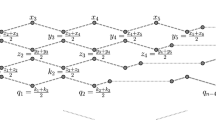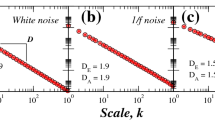Abstract
A new method of fractal analysis of nonstationary time series for recognition of critical (precatastrophic) and noncritical (quiet) modes of behaviour of open stochastic dynamical systems is developed. The method is a modification of the conventional detrended fluctuation analysis (DFA) technique. Unlike the classical DFA that originates in the R/S analysis and implies investigation of the time series by studying the properties of a mixture of velocities and accelerations, the new method focuses on the study of accelerations only. Because at the most basic level the equations of motion of stochastic dynamical systems are expressions for the acceleration, the suggested method results to be more suitable for recognition of critical and noncritical states. Using both model and real data, we demonstrate superiority of the newly developed method over the conventional DFA and provide a detailed discussion on the topic.




Similar content being viewed by others
References
Ashkenazy, Y., Ivanov, PCh., Havlin, S., Peng, C.-K., Goldberger, A.L., Stanley, H.E.: Magnitude and sign correlations in heartbeat fluctuations. Phys. Rev. Lett. 86, 1900–1903 (2001)
Carbone, A., Castelli, G., Stanley, H.E.: Time-dependent Hurst exponent in financial time series. Physica A 344, 267–271 (2004)
Costa, M.D, Goldberger, A.L., Peng, C.-K.: Multiscale entropy analysis of biological signals. Phys. Rev. E 71, 021906-1–021906-18 (2005). doi:10.1103/PhysRevE.71.021906
Feder, J.: Fractals. Plenum Press, New York (1988)
Filatov, D.M., Lyubushin, A.A.: Assessment of seismic hazard of the Japanese islands based on fractal analysis of GPS time series. Izv. Phys. Solid Earth (in press)
Goldberger, A.L., Amaral, L.A.N., Hausdorff, J.M., Ivanov, PCh., Peng, C.-K., Stanley, H.E.: Fractal dynamics in physiology: alterations with disease and aging. Proc. Natl Acad. Sci. U.S.A. 99, 2466–2472 (2002)
Haken, H.: Information and Self-Organization: A Macroscopic Approach to Complex Systems. Springer, Berlin (2006). doi:10.1007/3-540-33023-2
Hurst, H.: Long-term storage capacity of reservoirs. Trans. Am. Soc. Civ. Eng. 116, 770–799 (1951)
Ivanov, PCh., Amaral, L.A.N., Goldberger, A.L., Havlin, S., Rosenblum, M.G., Stanley, H.E., Struzik, Z.R.: From 1/f noise to multifractal cascades in heartbeat dynamics. Chaos 11, 641–652 (2001)
Kantelhardt, J.W.: Fractal and Multifractal Time Series. arXiv:0804.0747 (2008)
Klimontovich, YuL: Turbulent Motion and the Structure of Chaos: A New Approach to the Statistical Theory of Open Systems. Springer, Berlin (1991). doi:10.1007/978-94-011-3426-2
Klimontovic, YuL: Statistical Theory of Open Systems: A Unified Approach to Kinetic Description of Processes in Active Systems. Springer, Berlin (1995). doi:10.1007/978-94-011-0175-2
Leistedt, S.J.-J., Linkowski, P., Lanquart, J.-P., Mietus, J.E., Davis, R.B., Goldberger, A.L., Costa, M.D.: Decreased neuroautonomic complexity in men during an acute major depressive episode: analysis of heart rate dynamics. Transl. Psychiatry 1, e27 (2011). doi:10.1038/tp.2011.23
Lipsitz, L.A., Goldberger, A.L.: Loss of ‘complexity’ and aging: potential applications of fractals and chaos theory to senescence. J. Am. Med. Assoc. 287, 1806–1809 (1992). doi:10.1001/jama.1992.03480130122036
Lyubushin, A.A.: Multifractal parameters of low-frequency microseisms. In: de Rubeis, V., Czechowski, Z., Teisseyre, R. (eds.) Geoplanet: Earth and Planetary Sciences, Synchronization and Triggering: From Fracture to Earthquake Processes, pp. 253–272. Springer, Berlin (2010)
Lyubushin, A.A., Yakovlev, P.V.: Properties of GPS noise at Japan islands before and after Tohoku mega earthquake. SpringerPlus 3, 364–381 (2014). doi:10.1186/2193-1801-3-364
Mandelbrot, B.B.: Fractals and Scaling in Finance: Discontinuity, Concentration, Risk. Springer, New York (1997)
Oświȩcimka, P., Kwapień, J., Drożdż, S., Rak, R.: Investigating multifractality of stock market fluctuations using wavelet and detrending fluctuation methods. Acta Phys. Polon. B 36, 2447–2457 (2005)
Peng, C.-K., Buldyrev, S.V., Goldberger, A.L., Havlin, S., Mantegna, R.N., Simons, M., Stanley, H.E.: Statistical properties of DNA sequences. Physica A 221, 180–192 (1995)
Peng, C.-K., Hausdorff, J.M., Mietus, J.E., Havlin, S., Stanley, H.E., Goldberger, A.L.: Fractals in physiological control: from heart beat to gait. In: Shlesinger, M.F., Zaslavsky, G.M., Frisch, U. (eds.) Lévy Flights and Related Topics in Physics, Proceedings of the International Workshop held at Nice, France, 27–30 June 1994. Lecture Notes in Physics, vol. 450, pp. 313–330. Springer, Berlin (1995)
Peng, C.-K., Havlin, S., Stanley, H.E., Goldberger, A.L.: Quantification of scaling exponents and crossover phenomena in nonstationary heartbeat time series. Chaos 5, 82–87 (1995)
PhysioBank Archive, a resource supported by the National Institute of General Medical Sciences (NIGMS) and National Institute of Biomedical Imaging and Bioengineering (NIBIB), the USA. https://physionet.org/physiobank/database/
Sornette, D.: Why Stock Markets Crash: Critical Events in Complex Financial Systems. Princeton University Press, Princeton (2003)
Voit, J.: The Statistical Mechanics of Financial Markets. Springer, Berlin (2005)
Acknowledgments
The author is grateful to the anonymous referees for their comments that have allowed to clarify and substantially improve the final version of the paper.
Author information
Authors and Affiliations
Corresponding author
Rights and permissions
About this article
Cite this article
Filatov, D.M. A Method for Identification of Critical States of Open Stochastic Dynamical Systems Based on the Analysis of Acceleration. J Stat Phys 165, 681–692 (2016). https://doi.org/10.1007/s10955-016-1641-6
Received:
Accepted:
Published:
Issue Date:
DOI: https://doi.org/10.1007/s10955-016-1641-6




